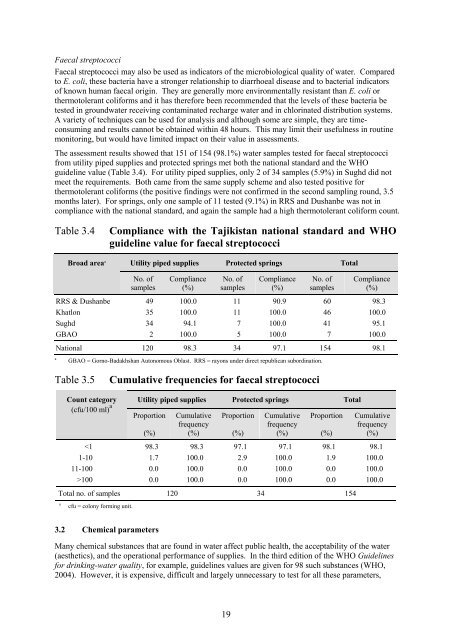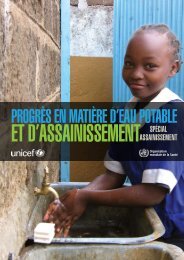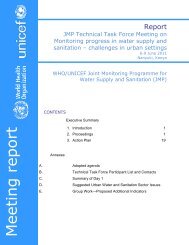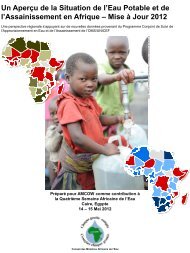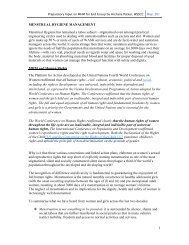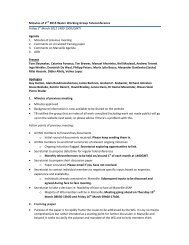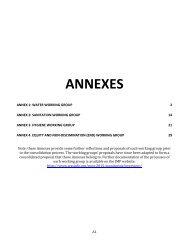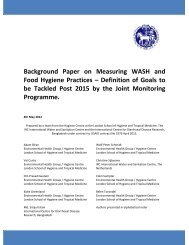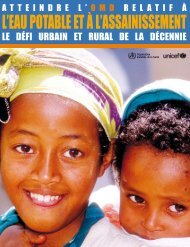rapid assessment of drinking-water quality in the republic of tajikistan
rapid assessment of drinking-water quality in the republic of tajikistan
rapid assessment of drinking-water quality in the republic of tajikistan
Create successful ePaper yourself
Turn your PDF publications into a flip-book with our unique Google optimized e-Paper software.
Faecal streptococci<br />
Faecal streptococci may also be used as <strong>in</strong>dicators <strong>of</strong> <strong>the</strong> microbiological <strong>quality</strong> <strong>of</strong> <strong>water</strong>. Compared<br />
to E. coli, <strong>the</strong>se bacteria have a stronger relationship to diarrhoeal disease and to bacterial <strong>in</strong>dicators<br />
<strong>of</strong> known human faecal orig<strong>in</strong>. They are generally more environmentally resistant than E. coli or<br />
<strong>the</strong>rmotolerant coliforms and it has <strong>the</strong>refore been recommended that <strong>the</strong> levels <strong>of</strong> <strong>the</strong>se bacteria be<br />
tested <strong>in</strong> ground<strong>water</strong> receiv<strong>in</strong>g contam<strong>in</strong>ated recharge <strong>water</strong> and <strong>in</strong> chlor<strong>in</strong>ated distribution systems.<br />
A variety <strong>of</strong> techniques can be used for analysis and although some are simple, <strong>the</strong>y are timeconsum<strong>in</strong>g<br />
and results cannot be obta<strong>in</strong>ed with<strong>in</strong> 48 hours. This may limit <strong>the</strong>ir usefulness <strong>in</strong> rout<strong>in</strong>e<br />
monitor<strong>in</strong>g, but would have limited impact on <strong>the</strong>ir value <strong>in</strong> <strong>assessment</strong>s.<br />
The <strong>assessment</strong> results showed that 151 <strong>of</strong> 154 (98.1%) <strong>water</strong> samples tested for faecal streptococci<br />
from utility piped supplies and protected spr<strong>in</strong>gs met both <strong>the</strong> national standard and <strong>the</strong> WHO<br />
guidel<strong>in</strong>e value (Table 3.4). For utility piped supplies, only 2 <strong>of</strong> 34 samples (5.9%) <strong>in</strong> Sughd did not<br />
meet <strong>the</strong> requirements. Both came from <strong>the</strong> same supply scheme and also tested positive for<br />
<strong>the</strong>rmotolerant coliforms (<strong>the</strong> positive f<strong>in</strong>d<strong>in</strong>gs were not confirmed <strong>in</strong> <strong>the</strong> second sampl<strong>in</strong>g round, 3.5<br />
months later). For spr<strong>in</strong>gs, only one sample <strong>of</strong> 11 tested (9.1%) <strong>in</strong> RRS and Dushanbe was not <strong>in</strong><br />
compliance with <strong>the</strong> national standard, and aga<strong>in</strong> <strong>the</strong> sample had a high <strong>the</strong>rmotolerant coliform count.<br />
Table 3.4<br />
Broad area a<br />
Compliance with <strong>the</strong> Tajikistan national standard and WHO<br />
guidel<strong>in</strong>e value for faecal streptococci<br />
Utility piped supplies Protected spr<strong>in</strong>gs Total<br />
No. <strong>of</strong><br />
samples<br />
Compliance<br />
(%)<br />
No. <strong>of</strong><br />
samples<br />
Compliance<br />
(%)<br />
No. <strong>of</strong><br />
samples<br />
Compliance<br />
(%)<br />
RRS & Dushanbe 49 100.0 11 90.9 60 98.3<br />
Khatlon 35 100.0 11 100.0 46 100.0<br />
Sughd 34 94.1 7 100.0 41 95.1<br />
GBAO 2 100.0 5 100.0 7 100.0<br />
a<br />
National 120 98.3 34 97.1 154 98.1<br />
GBAO = Gorno-Badakhshan Autonomous Oblast. RRS = rayons under direct <strong>republic</strong>an subord<strong>in</strong>ation.<br />
Table 3.5<br />
Cumulative frequencies for faecal streptococci<br />
Count category<br />
(cfu/100 ml) a<br />
Utility piped supplies Protected spr<strong>in</strong>gs Total<br />
Proportion<br />
(%)<br />
Cumulative<br />
frequency<br />
(%)<br />
Proportion<br />
(%)<br />
Cumulative<br />
frequency<br />
(%)<br />
Proportion<br />
(%)<br />
Cumulative<br />
frequency<br />
(%)<br />
100 0.0 100.0 0.0 100.0 0.0 100.0<br />
Total no. <strong>of</strong> samples 120 34 154<br />
a<br />
cfu = colony form<strong>in</strong>g unit.<br />
3.2 Chemical parameters<br />
Many chemical substances that are found <strong>in</strong> <strong>water</strong> affect public health, <strong>the</strong> acceptability <strong>of</strong> <strong>the</strong> <strong>water</strong><br />
(aes<strong>the</strong>tics), and <strong>the</strong> operational performance <strong>of</strong> supplies. In <strong>the</strong> third edition <strong>of</strong> <strong>the</strong> WHO Guidel<strong>in</strong>es<br />
for <strong>dr<strong>in</strong>k<strong>in</strong>g</strong>-<strong>water</strong> <strong>quality</strong>, for example, guidel<strong>in</strong>es values are given for 98 such substances (WHO,<br />
2004). However, it is expensive, difficult and largely unnecessary to test for all <strong>the</strong>se parameters,<br />
19


